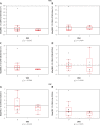Stem cells mobilization by cardiopulmonary bypass after coronary artery bypass grafting
- PMID: 36967861
- PMCID: PMC10031675
- DOI: 10.5114/aic.2022.122874
Stem cells mobilization by cardiopulmonary bypass after coronary artery bypass grafting
Abstract
Introduction: Expression of haematopoietic stem and progenitor cells occurs as a result of an inflammatory reaction caused by a damaged organ. Patients undergoing coronary artery bypass surgery (CABG) using cardiopulmonary bypass (CPB) are exposed to an inflammatory reaction, which may be a trigger in the mobilization of regenerative cells.
Aim: To assess the impact of CPB on stem and progenitor cells mobilization in patients scheduled for CABG.
Material and methods: Twenty patients with stable coronary disease, who were scheduled for CABG, were included in the study. Peripheral blood samples were collected perioperatively: 2 h before surgery, before CPB, at CPB weaning, 24 h postoperatively, and on the 6th postoperative day. Analyses of immune-labelled cells were carried out on an ImageStream (IS) system.
Results: The following cell populations were identified during cardiac surgery: haematopoietic stem cells (HSC), mesenchymal cells (MSC), endothelial progenitors (EPC), and very small embryonic-like cells (VSEL). The profile of cell mobilization coincides with the perioperative inflammatory response. Mobilization of stem and progenitor cells induced by CPB did not occur in any of the isolated cell lines (p > 0.05). The expression profile of stem and progenitor cells was related with the inflammatory reaction associated with traumatic stress in all cell lines. Type 2 diabetes is a disease that is hampering the trend of MSC mobilization.
Conclusions: Mobilization of haematopoietic stem and progenitor cells was not related with CPB. The inflammatory reaction was associated with perioperative trauma. Cell release was inhibited in patients with diabetes.
Keywords: cardiopulmonary bypass; coronary artery disease; inflammation; stem cells.
Copyright: © 2022 Termedia Sp. z o. o.
Conflict of interest statement
The authors declare no conflict of interest.
Figures





References
-
- Ratajczak MZ, Liu R, Marlicz W, et al. . Identification of very small embryonic/epiblast-like stem cells (VSELs) circulating in peripheral blood during organ/tissue injuries. Methods Cell Biol 2011; 103: 31-54. - PubMed
-
- Adler CP, Costabel U. Cell number in human heart in atrophy, hypertrophy, and under the influence of cytostatics. Recent Adv Stud Cardiac Struct Metab 1975; 6: 343-55. - PubMed
-
- Yu J, Vodyanik MA, Smuga-Otto K, et al. . Induced pluripotent stem cell lines derived from human somatic cells. Science 2007; 318: 1917-20. - PubMed
-
- Lai VK, Ang KL, Rathbone W, et al. . Randomized controlled trial on the cardioprotective effect of bone marrow cells in patients undergoing coronary bypass graft surgery. Eur Heart J 2009; 30: 2354-9. - PubMed
-
- Jansen PG, Te Velthuis H, Oudemans-Van Straaten HM, et al. . Perfusion-related factors of endotoxin release during cardiopulmonary bypass. Eur J Cardiothorac Surg 1994; 8: 125-9. - PubMed
LinkOut - more resources
Full Text Sources
